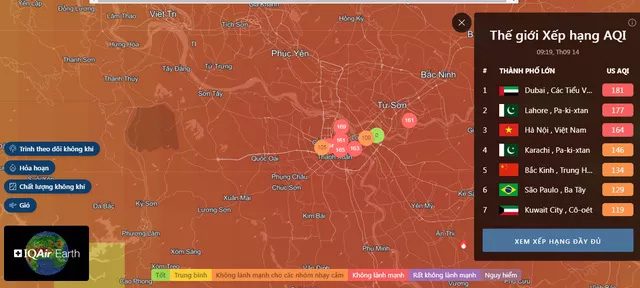This morning (September 14), according to the IQAir air quality index, Hanoi ranks as the third most polluted city in the world, with an average AQI of 164.
At 9 AM on September 14, the PAM Air application (the first and only independent air quality monitoring network in Vietnam, covering all 63 provinces and cities in the country) reported that the air quality index in Hanoi is at a significantly hazardous level. The highest recorded index was at Ngọc Thụy (Long Biên District) with 227, and Lê Văn Lương with 207, both classified as purple warning levels – extremely harmful to health.
Additionally, other areas such as the University of Foreign Languages recorded 158, E Hospital at 182, Nhân Chính at 151, Vĩnh Hồ at 192, Giảng Võ at 186, and the Academy of Finance at 157… all indicating hazardous air pollution levels.
The provinces and cities to the east of Hanoi also experience very poor air quality. The AQI in Bắc Ninh is 190 (with a point in TT Hồ reaching 199), Bắc Giang at 171, and Hải Dương at 158…

Real-time air quality map from AirVisual.
The AirVisual application (a product of the IQAir organization with a vast database on air quality, headquartered in Switzerland) ranks Hanoi as the third most polluted city among major cities worldwide. Dubai (United Arab Emirates) and Lahore (Pakistan) take the first and second spots with AQI readings of 181 and 177, respectively. Hanoi’s AQI of 164 places it third globally, surpassing Beijing (China).
The VN Air application from the General Department of Environment (Ministry of Natural Resources and Environment) recorded that both monitoring points in Hanoi are polluted. The point at 556 Nguyễn Văn Cừ (Long Biên District) shows a red level of pollution – where normal individuals may begin to experience health effects, and sensitive groups could face more serious health issues. The point at the Environmental Protection Sub-department (Đống Đa District) recorded an orange level.
Experts recommend that during periods of air pollution, ordinary individuals should reduce strenuous outdoor activities and avoid prolonged exercise. Those experiencing symptoms such as eye pain, cough, or sore throat should consider limiting outdoor activities.
It is best for residents to stay indoors and minimize physical activity. If it is absolutely necessary to go outside, wearing a certified mask is advisable.
Previously, to address deficiencies in air pollution control, the Hanoi People’s Committee requested all levels and sectors to continue implementing effective and coordinated solutions to improve air quality.
According to the directives from the Hanoi People’s Committee, departments, sectors, and localities are to continue to actively and effectively implement Directive No. 15/CT-UBND dated October 30, 2019, regarding the replacement and elimination of all use of charcoal stoves in daily life and business services to minimize negative environmental impacts, ensuring the complete removal of 100% of charcoal stoves in the city by 2022; Directive No. 19/CT-UBND dated December 25, 2019, regarding measures to address and limit pollution and improve air quality indices in the city; and Directive No. 15/CT-UBND dated September 18, 2020, on enhancing state management measures regarding the burning of straw, crop residues, and other waste inappropriately to minimize negative environmental impacts.
Accordingly, the People’s Committees of districts, towns, and cities will be fully responsible if charcoal stoves and straw burning occur in their areas.


















































